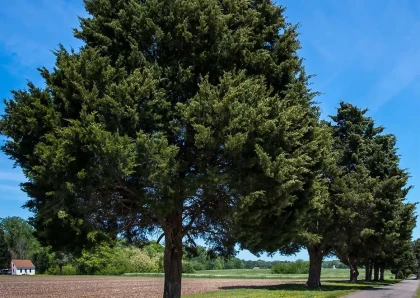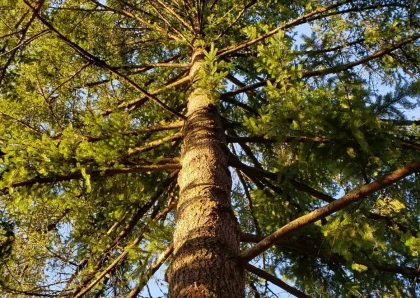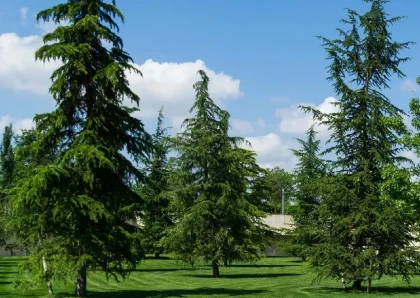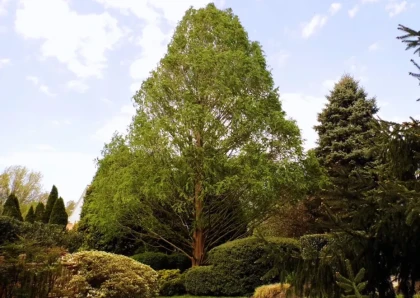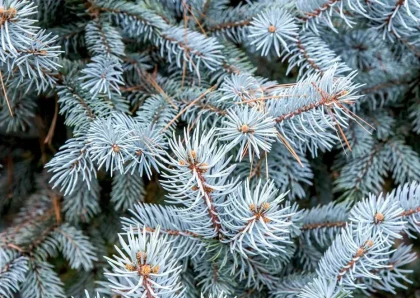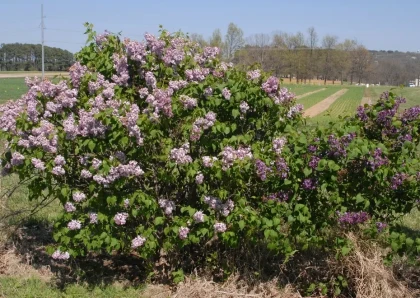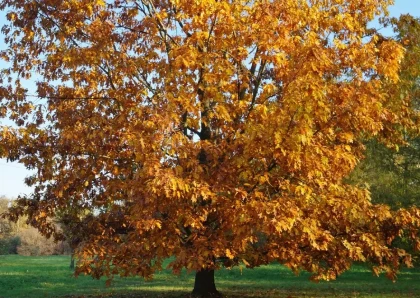
American Cranberrybush Viburnum Tree
Overview
Description:
The American Cranberrybush Viburnum (Viburnum trilobum) is a deciduous shrub/tree native to North America. It is commonly found in moist woods, swamps, and along stream banks. This versatile plant is known for its attractive appearance, featuring beautiful foliage, vibrant berries, and a rounded shape that can resemble a small tree when mature.
Appearance:
The American Cranberrybush Viburnum typically grows up to 8-12 feet in height and has a similar spread. It has a multi-stemmed growth habit and develops arching branches. The leaves are maple-like, with three distinct lobes and serrated edges. During the growing season, the foliage displays shades of dark green, which turn brilliant shades of red, orange, and burgundy in the fall, adding ornamental value to the landscape.
Flowers and Berries:
In late spring to early summer, the American Cranberrybush Viburnum produces flat clusters of small, creamy-white flowers. These clusters can be up to 3-5 inches in diameter and attract various pollinators, including bees and butterflies. Following the flowering period, the plant forms attractive red berry-like fruits, which mature to a glossy, bright red color in the fall. The berries persist throughout the winter, providing food for birds and adding winter interest to the garden.
Cultivation:
The American Cranberrybush Viburnum is relatively easy to cultivate and is adaptable to a wide range of soil conditions, from moist to well-drained, and prefers full sun to partial shade. Once established, it exhibits good drought tolerance. Pruning can be done after flowering to maintain the desired shape and size. This viburnum is generally pest and disease-resistant, making it a low-maintenance addition to landscapes and gardens.
Uses:
The American Cranberrybush Viburnum has several practical uses in landscaping. It can be planted as a hedge, a specimen plant, or in groups to create a naturalistic planting. The berries are attractive to birds and wildlife, making it a valuable addition to wildlife gardens.
Types of American Cranberrybush Viburnum Trees
-
American Cranberrybush Viburnum (Viburnum trilobum)
This is the standard species of American Cranberrybush Viburnum with the typical characteristics described in the overview.
-
Viburnum trilobum 'Compactum'
This cultivar is a more compact version of the American Cranberrybush Viburnum, growing to a smaller size while retaining its attractive features.
-
Viburnum trilobum 'Bailey Compact'
Another compact cultivar, 'Bailey Compact,' is known for its denser growth and is suitable for smaller gardens or limited spaces.
-
Viburnum trilobum 'Wentworth'
'Wentworth' is a cultivar valued for its intense red fall foliage, making it a striking addition to autumn landscapes.
-
Viburnum trilobum 'Jewell Box'
'Jewell Box' is a dwarf variety, ideal for small gardens or container planting, and it also produces abundant berries.
Wood Products from American Cranberrybush Viburnum Tree
-
Furniture
The wood of the American Cranberrybush Viburnum tree can be used to craft beautiful and durable furniture pieces. Its fine-grained and strong wood makes it suitable for making chairs, tables, cabinets, and more.
-
Tool Handles
The sturdy nature of American Cranberrybush Viburnum wood makes it an excellent choice for tool handles. It provides a comfortable grip and can withstand the forces exerted during various tasks.
-
Crafts and Carvings
The fine texture and workability of the wood make it a popular choice for crafts and carvings. Artisans can create intricate designs and decorative items using the wood of this tree.
-
Cabinetry
American Cranberrybush Viburnum wood is well-suited for cabinetry work. Its appealing grain patterns and ability to take stains and finishes make it an attractive choice for kitchen and bathroom cabinets.
-
Wooden Utensils
The wood from this tree can be used to craft wooden utensils such as spoons, spatulas, and cutting boards. Its non-toxic properties make it safe for food contact.
-
Small Specialty Items
The versatility of American Cranberrybush Viburnum wood allows for the creation of various small specialty items, including jewelry boxes, picture frames, and pen holders.
Benefits of American Cranberrybush Viburnum Tree
-
Attractive Landscape Plant
The American Cranberrybush Viburnum adds beauty to landscapes with its maple-like leaves, colorful berries, and vibrant fall foliage, making it an appealing choice for gardens and naturalistic plantings.
-
Wildlife Attraction
The red berries produced by the tree attract various bird species, such as thrushes, robins, and waxwings. It also provides a food source for small mammals during the winter months.
-
Pollinator-friendly
The creamy-white flowers of the American Cranberrybush Viburnum are a valuable nectar and pollen source for bees, butterflies, and other pollinators, supporting local ecosystems.
-
Low Maintenance
Once established, the American Cranberrybush Viburnum is relatively low-maintenance, as it is generally resistant to pests and diseases and can tolerate a variety of soil conditions.
-
Seasonal Interest
The tree provides year-round interest, from the spring flowering and summer foliage to the striking fall colors and persistent winter berries, ensuring a visually appealing landscape throughout the seasons.
-
Soil Erosion Control
With its dense root system, the American Cranberrybush Viburnum helps stabilize soil and prevent erosion, making it a useful choice for planting on slopes or near water bodies.
-
Adaptable and Versatile
This viburnum species can thrive in various environmental conditions, from moist areas to well-drained soils, and can be used for hedging, screening, or as a specimen plant.
Cons of Using American Cranberrybush Viburnum Tree
-
Aggressive Spreading
The American Cranberrybush Viburnum has a tendency to spread through suckering, forming dense thickets. This can be problematic in certain landscapes or when attempting to maintain a controlled garden design.
-
Wildlife Conflicts
While the red berries are attractive to wildlife, they can also lead to potential conflicts. Birds may consume the berries and then deposit the seeds in unwanted areas, leading to the plant's rapid spread.
-
Pruning Challenges
Pruning the American Cranberrybush Viburnum can be a bit challenging due to its dense growth and tendency to produce new suckers. Regular and strategic pruning is necessary to maintain its shape and prevent overgrowth.
-
Potential Invasive Behavior
In certain regions, the American Cranberrybush Viburnum can exhibit invasive tendencies and outcompete native vegetation, disrupting local ecosystems. It's important to check with local authorities before planting it in natural areas.
-
Variable Berry Production
The berry production of the American Cranberrybush Viburnum can vary from year to year, depending on factors such as weather conditions and pollination rates. In some years, the fruit set may not be as abundant.
-
Deer Attraction
While the berries are loved by birds, they can also attract deer to the area. In regions with high deer populations, this can lead to potential damage to the plant and surrounding landscape.
Tips for Planting and Maintaining American Cranberrybush Viburnum Tree
-
Choosing the Right Location
Select a planting location with well-drained soil and full to partial sunlight. The American Cranberrybush Viburnum can tolerate a range of soil types, but it thrives best in moist, fertile soil.
-
Planting Time
For best results, plant the tree in the early spring or fall. This allows the plant to establish its root system before facing extreme temperatures.
-
Proper Spacing
When planting multiple American Cranberrybush Viburnum Trees, ensure they are spaced at least 6 to 10 feet apart to allow sufficient room for growth and proper air circulation.
-
Watering
Keep the newly planted tree well-watered during its initial establishment period. Once established, it is moderately drought-tolerant, but regular watering during dry spells is beneficial.
-
Mulching
Apply a layer of organic mulch around the base of the tree, but keep it away from the trunk. Mulch helps retain moisture, suppress weeds, and regulate soil temperature.
-
Pruning
Prune the American Cranberrybush Viburnum after it finishes flowering, typically in late spring or early summer. Remove any dead or diseased wood and trim to shape the plant as desired.
-
Fertilizing
Fertilize the tree in the early spring with a balanced, slow-release fertilizer. Avoid excessive nitrogen, as it may promote vegetative growth at the expense of flower and fruit production.
-
Pest and Disease Monitoring
Regularly inspect the tree for any signs of pests or diseases. Promptly address any issues to prevent them from spreading and affecting the overall health of the tree.
-
Bird Protection
If you want to enjoy the berries on the tree, consider using bird netting during the fruiting season to protect the berries from birds and other wildlife.
Conclusion for American Cranberrybush Viburnum Tree
In conclusion, the American Cranberrybush Viburnum (Viburnum trilobum) is a versatile and attractive shrub/tree that brings numerous benefits to landscapes and gardens. Its maple-like leaves, vibrant berries, and stunning fall colors make it a beautiful addition to any outdoor space.
This native North American plant not only provides visual appeal but also offers ecological value. The red berries attract various bird species and pollinators, supporting local wildlife and biodiversity. Additionally, its ability to stabilize soil helps prevent erosion, making it a valuable choice for landscape design.
When planting the American Cranberrybush Viburnum, choosing the right location with well-drained soil and proper sunlight is essential for its successful establishment. Regular watering during its early growth phase ensures a healthy root system.
Maintaining this viburnum tree involves strategic pruning to maintain its shape and density, while monitoring for potential pests and diseases is crucial for its long-term health.
While there are some considerations such as potential aggressive spreading and deer attraction, the benefits of planting and maintaining the American Cranberrybush Viburnum Tree far outweigh the drawbacks.
Overall, this adaptable and low-maintenance tree is an excellent choice for those seeking a visually appealing, wildlife-friendly, and environmentally beneficial addition to their outdoor spaces.
Frequently Asked Questions (FAQs)
-
1. What is the botanical name of the American Cranberrybush Viburnum?
The botanical name of the American Cranberrybush Viburnum is Viburnum trilobum.
-
2. Can the American Cranberrybush Viburnum Tree be grown as a small tree?
Yes, with proper pruning and care, the American Cranberrybush Viburnum can be trained to grow as a small tree with a rounded shape.
-
3. When does the American Cranberrybush Viburnum flower?
The American Cranberrybush Viburnum typically flowers in late spring to early summer, producing flat clusters of creamy-white flowers.
-
4. Are the berries of the American Cranberrybush Viburnum edible?
Yes, the berries are edible but are known to be quite tart. They are often used in jams, jellies, and sauces.
-
5. How tall does the American Cranberrybush Viburnum Tree grow?
The American Cranberrybush Viburnum typically grows to a height of 8-12 feet with a similar spread.
-
6. Is the American Cranberrybush Viburnum Tree deer-resistant?
While the American Cranberrybush Viburnum is generally deer-resistant, deer may still browse on the plant, especially in regions with high deer populations.
-
7. Can I plant the American Cranberrybush Viburnum in full sun?
Yes, the American Cranberrybush Viburnum can tolerate full sun to partial shade, but it prefers a location with at least partial sunlight.
-
8. How do I propagate the American Cranberrybush Viburnum Tree?
The American Cranberrybush Viburnum can be propagated through softwood cuttings in early summer or hardwood cuttings in late fall. It can also spread naturally through suckering.




